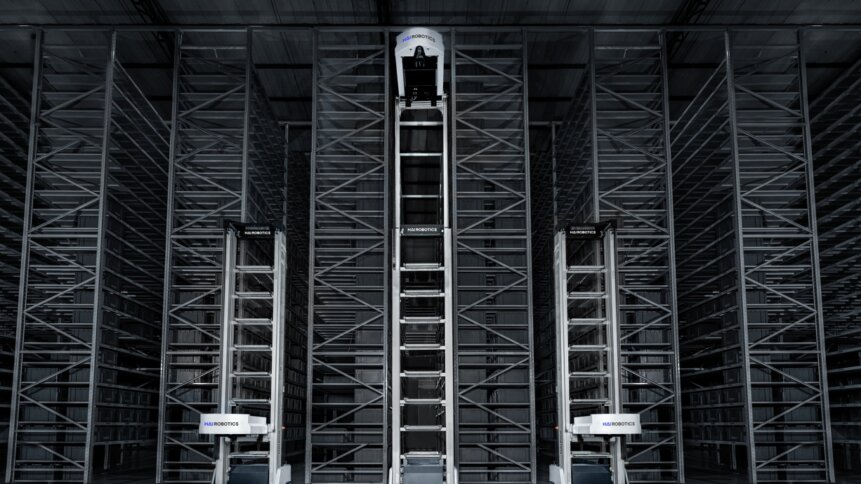The warehouse of the future

The idea that the warehouse of the future will be entirely automated, filled with robots rather than people, has been the stuff of science fiction for generations. But the future of those science fiction stories is now the stuff of our everyday reality – or almost.
We sat down with Damien Skinner, UK Country Manager at Hai Robotics, for a look at what the warehouse of the future looks like today.
THQ:
So…what does the warehouse of the future look like today? In broad terms, at least.
DS:
Well, right now, warehousing globally is driven by ecommerce – both on the huge scale, like Amazon, and, post-Covid, on a smaller scale too. And the big challenge for any warehouse owner is finding, training, and retaining the labor to work in it.
Traditional solutions involve erecting large, multi-level mezzanines, with zonal operators. But at this point – and certainly in the future – the financial investment to do that, especially with extensive staffing costs, is about the same or even more than implementing an automated robotic solution.
So the likelihood is that the warehouse of the future will include much more robotics and automation, and fewer humans in the traditional roles they’ve occupied up to this point, certainly for an ecommerce environment.
The alternative to tradition
What we’re seeing is that now, and in the short-to-medium term future, end users and operatives, like 3PL for example (third party logistics), are looking at alternatives to their traditional go-to solutions. And they’re finding that robotic solutions can cost a lot less in the long term when it comes to capital investment.
Add to that the productivity of a robotic solution, where you need fewer operatives to do the same amount of work, and there’s a good sense of what the future of the warehouse looks like from a technological standpoint, I think.
THQ:
And that goes down to the bone? To the building of facilities, for example?
DS:
Yes, if you’re looking at the lead time it would take for a mezzanine to be designed and built and sprinklered, and then finding the people to operate in it. You could erect racking and put some robots in in about the same time, around 9-10 months.
And that’s also an advantage we have over even more traditional automation. Traditional automation requires you to have lots of conveyors, lots of loads, lots of cranes, and there’s a space consequence to that. Whereas with modern robotics, you don’t need that much space – maybe you’ll have more islands of automation, but nothing like the big space-fillers.
And then, progressing through to the medium term, you’ll get more automation, which will tackle the space problem more directly. Space is at a premium in many countries, especially for building as large as traditional warehouses. Maybe it’s not such an issue in rural areas in the States, but for more urban warehousing – where you want local hubs, for instance – you need a space-efficient warehouse.
Right now, robotic warehouses can go up to 10 meters in height, and in the future, it could go up to 12 or even 15 meters. That way, you can have an efficient urban warehouse in a fraction of the space as far as the footprint is concerned.
And we’re just pushing the boundaries of what the technology can do. Right now we have a roving mini-loader that goes around, free roaming aisles within a racking solution, but when we started out, we could only go to 8 meters high, and only single deep in storage.
Now we can do 10 meters in height and go double deep in storage. That’s an impressive change within just six months.
And as I say, there’s a growing need for these high density storage warehouses, with high level robotic systems.
Build high for happiness
THQ:
So that’s where the trend is moving? At both ends of the scale, building higher, with significantly more automation and more robotics?
DS:
Yes, and as trends go, it’s moving very quickly. It’s almost akin to smartphones – you buy version 10, and before you know it, you’re using version 16, with increased and improved functionality, flexibility, and future-proofing. That’s happening at about the same pace with warehouse technology and robotics.
Warehouse operating systems in the future will be constantly updated with the latest innovations in algorithms and ways of controlling the robots.
THQ:
Indulge our science fiction brains for a moment. Are we looking at high rise warehouses with no humans in the future?
DS:
No.
THQ:
Oh.
DS:
No, I mean, I think depending on the industry, you’re seeing that now.
THQ:
Ah.
Warehouse of the present?
DS:
A well-known supermarket brand came to us earlier this month. They said “We like your technology. We want to build a fully autonomous warehouse.”
THQ:
Ah.
DS:
They want to go end to end with minimum human touch.
THQ:
Wow.
DS:
And if you break down the operations within a warehouse, from offloading, through the storage and retrieval, to the picking, packing and despatch, there’s an autonomous solution or a robotic solution for all of that now.
There are robots doing storage and retrieval and goods to person for picking. You can see item picking robots. You can see co-bots doing packing, or you can get automated packing machines where you put the item that’s being picked directly onto some plastic wrap and the plastic bag is formed perfectly around that item, ready to be shipped.
You can carry the process right the way through to precise vehicle loading, based on warehouse and logistics management. You can see that all now. That’s not even the warehouse of the future, that’s the warehouse of today.
But the people, though…
The question is one of acceptance – and acceptability – by the end users. Just because something is entirely possible, that doesn’t necessarily make it entirely popular.
THQ:
So that’s the battle for the future, essentially? Making the possibility of today the universally accepted truth of tomorrow?
DS:
Yes – but of course, while you’re doing that, the technology and its capabilities will evolve around you, too. That’s the thing about the future.
THQ:
It’s never quite what you think it is, because by the time you get there, it’s changed.
DS:
Exactly.
In Part 2 of this article, we’ll take a look at the practicalities of future warehouses full of robots – and how they might be significantly more flexible than any warehouse we’ve ever known.










